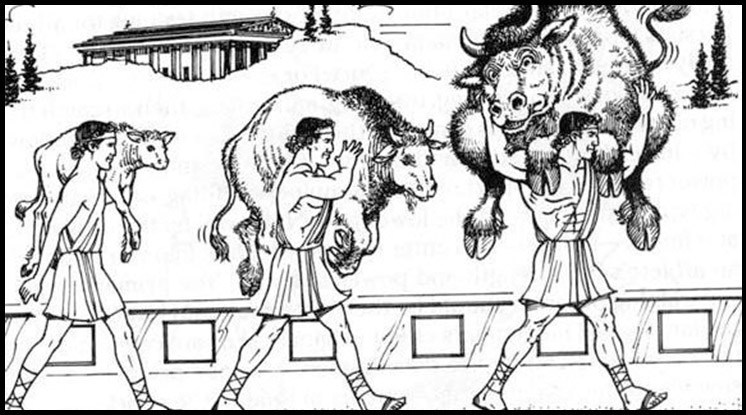
Milo of Croton was born in ancient Greece during the sixth century BC and was the most revered wrestler of his time. He was a five-time Olympic champion, and his feats of strength were legendary. But how did Milo get so strong, and what can we learn from this ancient strong man?
The story goes that one day a calf was born near Milo, and every day for four years Milo would lift the calf on to his shoulders and carry him… until one day he was no longer carrying a calf but a four year old bull! In reading this simple story, a couple of things jump out as relevant and timeless strength training principles.
1. Consistency is Key – Milo carried his calf every day. Carrying the calf once a week or sporadically would not have worked nearly as well, and eventually would have lead to failure. By being consistent, Milo’s strength grew as his calf grew, which brings us nicely to our second point….
2. Apply the Principles of Progressive Overload – Milo’s load got a little heavier every day. His body was forced to adapt to these heavier loads; as the calf grew heavier over time, Milo’s body grew stronger as a result.
As we strive to get stronger or to improve a physical skill, we must put these two principles into practice. Consistency is often a matter of commitment and time management. When physical fitness and strength gains are a priority in our lives, we are more likely to make the time for consistent workouts.
Progressive overload is the other half of the equation. If we are only consistent but never increase our workload, our bodies will not get stronger. The human body is amazingly built for adaptation but will always find stasis where possible. For example, a jogger who goes for a 3-mile run at the same pace everyday may be fit, but that jogger is not making any fitness gains. Likewise, the gym-goer who hits the gym 3 days a week and repeats the same routines at the same weights every week might be strong, but he or she is not getting stronger.
There are several ways we can employ the principles of progressive overload, and below are three of the most common. Let’s use the example of a lifter who’s programming currently has them squatting 150 lbs for three sets of ten repetitions once a week.
· Increase Load– this is the obvious one, simply add a little more weight to the bar. If your squats were three sets of ten reps at 150 lbs last week, do 155 lbs this week.
· Increase Repetitions– instead of increasing the load this week, we might choose to increase the repetitions. So instead of three sets of ten, we’ll do three sets of eleven.
· Decrease Rest Time – an alternate to the strategies above might be to decrease rest time between sets. If you rested 60 seconds between sets last week, rest 45 seconds this week.
Assumed within the principle of progressive overload is the concept of measurement. To apply these principles, we must track and measure our workouts. There are many ways to do this – from a good old-fashioned notebook and pen to highly sophisticated mobile phone apps. Choose whatever is most comfortable for you, but if you’re not already, start tracking your progress.
What do you think? Comment below and let us know how you apply these principles to your fitness lifestyle!
